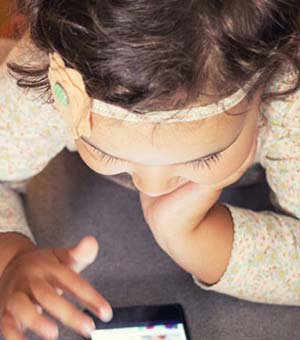
What to teach your preschooler about internet safety
News 2 FebruaryFifteen years ago, parents and caregivers did not have to worry about teaching pre-school aged children about internet safety.
02 February 2019
Share
Fifteen years ago, parents and caregivers did not have to worry about teaching pre-school aged children about internet safety. A new report prepared for the Children’s Commissioner of England suggests this time has passed.
Children now live in a digital age, which means internet access is a daily part of life for many young children around the world.

Touchscreen technologies have changed how accessible the internet is for very young children, particularly between the ages of four and five. It’s now quicker and easier to connect to the internet using these technologies, as they don’t require the same level of fine motor and literacy skills used to navigate a mouse and keyboard.
More recently, the Internet of Things has become widespread. The Internet of Things uses small chips embedded in everyday items, including children’s toys, to communicate information to the net. Children’s dolls, teddy bears and figurines can record their play and upload this information as data to the web. This can occur without children’s consent because they wouldn’t be aware they’re generating data.
Read more: Six things every consumer should know about the 'Internet of Things'
Internet safety addresses three main risks faced by children online. These are contact, conduct and content risks:
contact risks involve children talking to unknown people on the internet. Contact risks also include the harvesting of children’s data, such as recording their activity on an online game
conduct risks are about behaving respectfully online and learning to manage digital footprints
content risks are concerned with the type of material children view and consume when accessing the internet.
For pre-school aged children, content risks include accidentally viewing inappropriate content such as pornography. Content also considers the quality of material made available to children. How people are represented in society is mirrored back to children through the media they consume. Quality content for young children has been a concern of the Australian Council on Children and the Media for many years.
Read more: The way your children watch YouTube is not that surprising – but it is a concern. Here are some tips
Contact risks are most likely to occur for pre-school aged children in the form of pop-ups. Children of this age can also be active in virtual worlds, such as Pocoyo World or Club Penguin, where they can engage with other members. Children may not always know the members they are playing with in these worlds.
Conduct involves learning how to be respectful online. Parents can model good conduct behaviours to their children by always asking permission to take photos before posting to social media.
Internet safety in early childhood is a new area of research because, until now, children as young as four weren’t able to easily access the internet.
A recent study conducted with 70 four-year old children examined what children understand about the internet and being safe online. In this study, only 40% of children were able to describe the internet. This was despite all of the children having access to internet at home, predominately through touchscreen technologies.
Children’s understandings of the internet were associated with their experiences going online and using technologies with their families. They defined the internet as being “in the iPad” or something they used “in the lounge room” to “play games”.
Children were also aware the internet “was used by Mummy for her work” or “by my big sister for her emails”. Some 73% of the children said they would tell someone their address on the internet. And 70% said they would also tell someone how old they were. A further 89% of children indicated they would click on a pop-up even if they did not know what the pop-up was about.
Because children face content, contact and conduct risks online, they require a basic understanding of the internet. The most important thing parents can teach their children about internet safety is that “the internet” means a network of technologies that can “talk” to each other.
This is like teaching children to be sun smart. First, we explain the sun can harm our skin. Next we teach children to wear a hat, a long-sleeved shirt and sunscreen to protect themselves.
For internet safety, we should first explain the internet uses many technologies that share information created and collected by lots of people. Then we can teach our children how to protect themselves online. Some things to teach your child are:
seek adult help when you encounter a pop-up
only use adult approved sources for content
don’t share personal information online
try to be near an adult when using a device
only click on apps and tabs a parent or caregiver has set up for you.
The internet forms a large part of daily life for many young children. From watching their favourite YouTube clips, to playing games, to talking with a long-distance relative over video-conferencing, being online is not much different to a young child than being offline. Being safe in both spaces is possible with adult support.
Susan Edwards, Professor of Education, Australian Catholic University
This article was originally published on The Conversation. Read the original article.

Fifteen years ago, parents and caregivers did not have to worry about teaching pre-school aged children about internet safety.

The NSW Office of the Children’s Guardian has created a number of useful resources to support and promote child-safe organisations.

ACU Institute of Child Protection Studies Director, Prof Daryl Higgins, writes for The Conversation.

Researchers from the ACU Institute of Child Protection Studies will examine the role of ethical practice in improving child safety.

Historian and Emeritus Professor Shurlee Swain has been elected a Fellow of the Australian Academy of the Humanities. This is the highest honour for achievement in the humanities in Australia.
Visit Service Central to access Corporate Services.